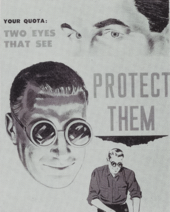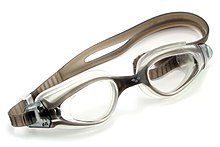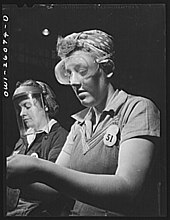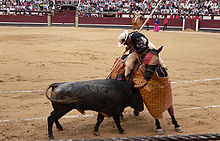Goggles

Goggles,orsafety glasses,are forms ofprotective eyewearthat usually enclose or protect the area surrounding the eye in order to prevent particulates, water orchemicalsfrom striking theeyes.They are used inchemistrylaboratories and inwoodworking.They are often used in snow sports as well, and inswimming.Goggles are often worn when usingpower toolssuch asdrillsorchainsawsto prevent flying particles from damaging the eyes. Many types of goggles are available as prescription goggles for those with vision problems.
History

TheInuitandYupikcarvedsnow gogglesfrom theantlersofcaribou,wood, and shell to help preventsnow blindness.The goggles were curved to fit the user's face and had a large groove cut in the back to allow for the nose. A long thin slit was cut through the goggles to allow in a small amount of light, diminishing subsequentultravioletrays. The goggles were held to the head by a cord made of caribousinew.

In the early 20th century, goggles were worn by drivers of uncovered cars to prevent irritation of the eyes by dust or wind.[1]Likewise in the first ten years after the invention of the airplane in 1903 goggles became a necessity as wind blow became more severe as aircraft speeds increased and as protection against bugstrikes at high altitudes. The first pilot to wear goggles was probablyCharles Manlyin his failed attempt to flySamuel Langley'saerodrome in 1903.
In 1875,Matthew Webbattempted to use a form of goggles without a seal (which he called "barnacles" ) on his first attempt atswimming across the English Channel,the intent was to shield his eyes from the splashing of the salt water.[2]
Types
The requirements for goggles varies depending on the use. Some examples:
- Cold weather: Most modern cold-weather goggles have two layers oflensto prevent the interior from becoming "foggy". With only a single lens, the interiorwater vaporcondenses onto the lens because the lens is colder than the vapor, althoughanti-fogagents can be used. The reasoning behind the dual layer lens is that the inner lens will be warm while the outer lens will be cold. As long as the temperature of the inner lens is close to that of the interior water vapor, the vapor should not condense. However, if water vapor gets between the layers of the lens, condensation can occur between the lenses and is almost impossible to get rid of; thus, properly constructed and maintained dual layer lenses should be airtight to prevent water vapor from entering between the lenses.

- Swimming:Must be watertight to prevent water, such assalt waterwhen swimming in theocean,orchlorinatedwater when swimming in a pool, from irritating the eyes or blurring vision. Allow swimmers to see clearly underwater. They will not be usable more than a few feet underwater, because the water pressure will press them tightly against the face. (Below this limit, adiving maskmust be used, which allows the user to equalize pressure by exhaling air through the nose.) Examples of these includeSwedish goggles.

- Power tools:Must be made of an unbreakable material that prevents chunks of metal, wood, plastic, concrete, and so on from hitting or piercing the eye, usuallypolycarbonate.Usually has some sort of ventilation to prevent sweat from building up inside the goggles and fogging the surface.

- Blowtorch goggles:These protect the eyes from glare and flying sparks and hot metal splashes while using or near ablowtorch.They arenotthe correct filters forarc welding.
- Welding goggles:Includes all goggles for eye protection during welding or cutting. They provide protection against debris, the heat from welding, and, with the proper filters, the optical radiation resulting from the welding, which can otherwise causearc eye.
- Motorcycleriding and other open-air activities: Prevents insects, dust, and so on from hitting the eyes.
- Laboratoryandresearch:Combines impact resistance with side shields to prevent chemical splashes reaching the eyes. May also includelaser protectionwhich would be covered byEN 207(Europe) and ANSI Z 136 (United States). Examples of these includered adaptation goggles.
- Racquetball:Protect the eyes from racquets swinging in an enclosed area and from impact from hard rubber ball.

- Winter sports:Protect the eyes fromglareand from icy particles flying up from the ground. Double lens anti-fog ski goggles were invented and patented by Robert Earl "Bob" Smith.[3][4][5]Visible Light Transmission (VLT) or S value describes the percentage of light allowed through the lens.[6]
- Astronomyandmeteorology:dark adaptor gogglesare used before going outside at night, in order to help the eyes adapt to the dark.
- Basketball:SeveralNBAplayers have worn goggles during play, includingKareem Abdul-Jabbar,James Worthy,Horace Grant,Kurt RambisandAmar'e Stoudemire;they prevent a fellow player from scratching or hitting the eyes when trying to grab the basketball. In most circumstances, a player starts wearing protective goggles to preventfurtherinjury to the eyes.
- Gaelic handballandsquash:goggles are worn to protect the eye from injury by the ball. The ball used in these sports is smaller than theeye socket,meaning that it can strike the eyeball directly.[7][8][9]
- Aviation:In opencockpitaircraft, such as oldbiplanes,aviators,such asAmelia EarhartandCharles Kingsford Smith,would wear goggles to help protect from the wind and are still in use today. Examples of these include theAN-6530 goggles.
- Virtual reality:A virtual reality headset, sometimes called "goggles", is a wrap-around visual interface to display computer output. Commonly the computer display information is presented as a three-dimensional representation of real-world environments.
- Drunkenness:Goggles designed to simulate the vision altering effects ofpsychoactive drugs,in particularalcohol.Examples includeFatal Vision goggles.There are no studies that have found beneficial effects of use of fatal vision goggles on the likelihood that individuals will later engage in impaired driving.[10][11]
Fashion
Goggles are often worn as a fashion statement in certain subcultures, most often as part of thecybergothsubculture. They are usually worn over the eyes or up on the forehead to secure 'falls': a type of long, often brightly coloured, synthetic hairpiece. Fans of thesteampunkgenre or subculture also frequently wear steampunk-styled goggles, particularly when performing in alive action role-playing game.
Goggles are also frequently used byanimeandmangacharacters as a fashion statement. For example, it is an idiosyncrasy of team leader characters in theDigimonanime to wear goggles. Other notable characters who wear goggles are the youngNaruto Uzumakiand Konohamaru fromNaruto,Matt fromDeath NoteandUsoppfromOne Piece.
Non-human


Goggles are available forhorsesused in speed sports such ashorse racing.[12]In some traditions of horse mountedbullfighting,the horse may wear a protective cloth over its eyes.
Goggles have been used onmilitary working dogs,for protection in harsh conditions, such as sandstorms and rotorwash from helicopters.
See also
- Ballistic eyewear– Form of glasses or goggles that protect from small projectiles and fragments
- Beer goggles– Impact of alcoholic inebriation on interpersonal attraction
- Google Goggles– Downloadable image recognition application created by Google
- Night-vision device– Device that allows visualization of images in levels of light approaching total darkness
- Personal protective equipment– Equipment designed to help protect an individual from hazards
- Safety engineering– Engineering discipline which assures that engineered systems provide acceptable levels of safety
- Visor– Surface that protects the eyes
References
- ^Alfred C. Harmsworth (1904).Motors and Motor-driving.Longmans, Green, and Company. p.73.
- ^Dolphin (1875).The Channel Feats of Captain Webb and Captain Boyton.160A, Fleet Street, London:Dean & Son.
{{cite book}}:CS1 maint: location (link) - ^"Ski goggle pioneer Bob Smith dies".Fox Sports.2012-04-27.Archivedfrom the original on 2020-06-27.Retrieved2020-06-25.
- ^US 4528701,Smith, Robert E., "Goggle with a renewable protective surface", published 1985-07-16
- ^US 4428081,Smith, Robert E., "Goggle with a renewable protective surface", published 1984-01-31
- ^"Sport Conrad".www.sport-conrad.com/.Archivedfrom the original on 2019-07-30.Retrieved2020-11-13.
- ^Kaddoura, Zeid (December 28, 2022)."Best Squash Goggles".The Racket Life.Archivedfrom the original on February 20, 2023.RetrievedFebruary 20,2023.
- ^"Sports injuries: 'I never saw it coming' - Optician".www.opticianonline.net.Archivedfrom the original on 2023-02-20.Retrieved2023-02-20.
- ^"Epidemiology of Injury in Gaelic Handball – Irish Medical Journal".Archivedfrom the original on 2023-03-28.Retrieved2023-02-20.
- ^Meeker, Miranda; Kehl, LeAnna (2020). "Substance use: Are specialized goggles effective at preventing impaired driving".Skeptical Inquirer.44(3): 56.
- ^Jewell, J; Hupp, S.D. (2005). "Examining the effects of fatal vision goggles on changing attitudes and behaviors related to drinking and driving".Journal of Primary Prevention.26(6): 553–565.doi:10.1007/s10935-005-0013-9.PMID16228116.S2CID19762828.
- ^Landers T. A. (2006) Professional Care of the Racehorse, Revised Edition: A Guide to Grooming, Feeding, and Handling the Equine Athlete. Blood Horse Publications. 308 pages. Page 138.
